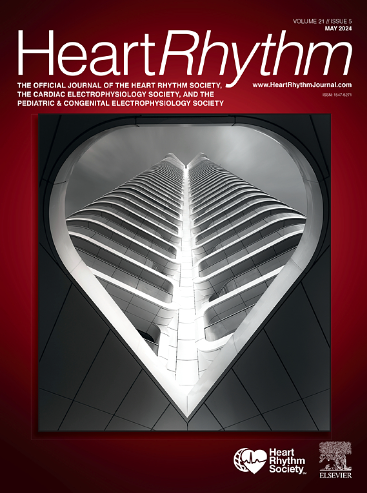High-density electroanatomic mapping of atriofascicular pathways using multipolar mapping catheters can identify oblique pathways and avoid mechanical bump termination
IF 5.7
2区 医学
Q1 CARDIAC & CARDIOVASCULAR SYSTEMS
引用次数: 0
Abstract
Background
Atriofascicular fibers (AFFs) are rare accessory pathways that have higher rates of recurrence after ablation because of either failure to identify AFF (M) potentials or mechanical termination with contact.
Objective
We aimed to evaluate whether electroanatomic mapping (EAM) using multielectrode, high-density nonlinear catheters can reliably localize AFF potentials and determine a site for ablation without causing mechanical termination.
Methods
Seven patients underwent electrophysiology studies (EPS) and EAM using high-density, multielectrode catheters for antidromic tachycardia using AFFs.
Results
Mean age at ablation was 15.5 ± 7.4 years, and 2 (29%) were female. Two had Ebstein’s anomaly. Three of 7 (43%) had previous ablation attempts. Of the previous attempts, 3 (60%) were complicated by mechanical termination during mapping. None of the previous ablation attempts was performed using high-density mapping catheters. HD Grid with Ensite NavX (Abbott Cardiovascular, Abbott Park, IL) was used in 3; the remainder used the PentaRay (3) or Optrell (1) catheters with CARTO (Biosense Webster, Irvine, CA). The AFF course was mapped to the lateral tricuspid annulus in all. Four of 7 had oblique courses with atrial insertion superior to the ventricular insertion. Multielectrode mapping catheters did not result in mechanical termination in any of these cases, whereas mechanical termination with ablation catheters occurred in 4 (57%). Successful ablation was performed in all with no recurrence over a 15 ± 6-month follow-up.
Conclusion
EAM using high-density multielectrode mapping catheters allow localization of atriofascicular pathways without causing mechanical termination and may improve long-term success of ablation. Majority of the pathways had oblique courses with atrial insertion superior to the ventricular insertion.
利用多极测图导管对房束通路进行高密度电解剖测图,可以识别斜向通路,避免机械碰撞终止。
背景:房束纤维(AFF)是一种罕见的辅助通路,在消融后由于无法识别AFF (M)电位和/或接触后机械终止而具有较高的复发率。目的:评估使用多电极高密度非线性导管的电解剖定位(EAM)是否能够可靠地定位AFF电位并确定消融部位,而不会引起机械终止。方法:7例患者采用高密度、多电极导管,利用afs治疗反性征性心动过速。结果:消融时平均年龄15.5 + 7.4岁,女性2例(29%)。其中两个人有Ebstein的异常。7人中有3人(43%)曾有消融尝试。在之前的尝试中,有三次(60%)在测绘过程中因机械终止而复杂化。先前的消融尝试均未使用高密度测绘导管。3采用Ensite NavX高清网格;其余使用PentaRay(3)或Optrell(1)导管与CARTO。所有患者的AFF路线均定位于外侧三尖环。7例中有4例为斜行,心房止点优于心室止点。在这些病例中,多电极定位导管没有导致机械终止,而消融导管的机械终止有4例(57%)。所有患者均成功消融,随访15+6个月无复发。结论:使用高密度、多电极定位导管的EAM可以定位房束通路,而不会引起机械终止,并可能提高长期消融的成功率。大多数路径为斜行,心房止点优于心室止点。
本文章由计算机程序翻译,如有差异,请以英文原文为准。
求助全文
约1分钟内获得全文
求助全文
来源期刊

Heart rhythm
医学-心血管系统
CiteScore
10.50
自引率
5.50%
发文量
1465
审稿时长
24 days
期刊介绍:
HeartRhythm, the official Journal of the Heart Rhythm Society and the Cardiac Electrophysiology Society, is a unique journal for fundamental discovery and clinical applicability.
HeartRhythm integrates the entire cardiac electrophysiology (EP) community from basic and clinical academic researchers, private practitioners, engineers, allied professionals, industry, and trainees, all of whom are vital and interdependent members of our EP community.
The Heart Rhythm Society is the international leader in science, education, and advocacy for cardiac arrhythmia professionals and patients, and the primary information resource on heart rhythm disorders. Its mission is to improve the care of patients by promoting research, education, and optimal health care policies and standards.
 求助内容:
求助内容: 应助结果提醒方式:
应助结果提醒方式:


